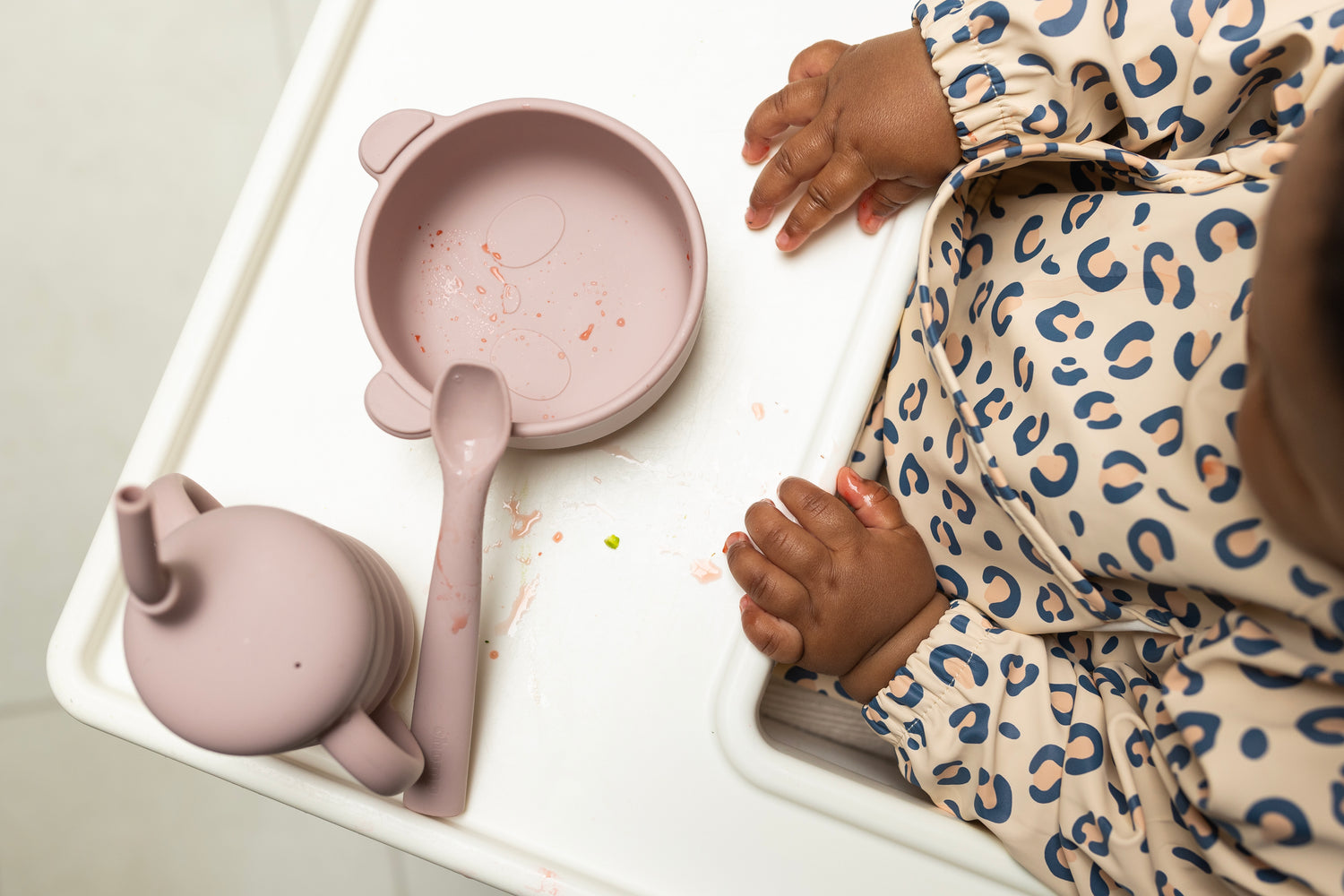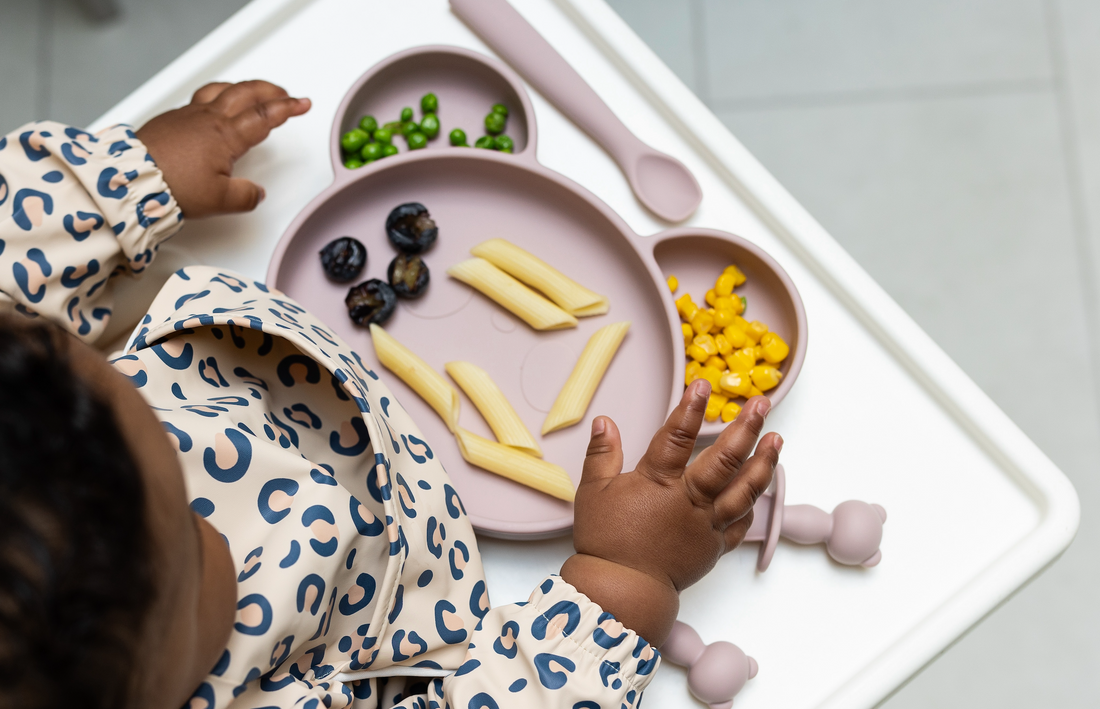What is the History of Weaning and Why Are Purées Still So Popular?
Weaning, the process of introducing solid foods to a baby's diet, has a long history that varies across cultures. Before formal guidelines, parents relied on traditional practices passed down through generations.
In 1994, the first official weaning guidelines suggested starting solids between 4 and 6 months of age. At this age, most babies weren't developmentally ready to self-feed, so spoon-feeding purées became the go-to method. The convenience and safety of purées made them especially popular, post-World War II promoting them as quick and nutritious options for busy parents.
Even after guidelines were updated in 2001 to recommend starting solids around 6 months, when babies are typically ready to self-feed, the habit of beginning with purées persisted. This tradition endures due to a mix of ingrained habits, easy access to commercial purées, and parental concerns about choking.

What are the signs baby is ready to start solids?
National Health Organisations suggest starting solids at 6 months of age once your little one can demonstrate the signs of readiness including;
- Strong neck muscles with the ability to hold their head and trunk steady with little support. If your child's head is falling forward and backwards, they are not ready as this can increase the risk of choking
- Hand eye coordination with the ability to bring food to their mouth
- Loss of the tongue-thrust response where they push food back out of their mouths instead of swallowing it
What Does BLW Mean? How Does BLW Work?
Baby-led weaning (BLW) is an approach to introducing solids where babies self-feed from the very beginning, using whole foods rather than purées. Instead of being spoon-fed, babies are offered a variety of soft, easy-to-handle foods and encouraged to explore and eat at their own pace.
In BLW, babies are in control of what they eat and how much. They pick up the food, bring it to their mouths, and chew at their own speed. This method not only helps babies develop fine motor skills and hand-eye coordination but also fosters a healthy relationship with food by allowing them to listen to their hunger and fullness cues.
What Are The Benefits of Baby Led Weaning?
- Baby eats what you eat. This means you can make one meal for the family and enjoy it together simplifying the weaning stage. BLW allows babies to join in on family meals, promoting social interaction and modeling healthy eating behaviours from parents and siblings.
- Saves time! Mealtime becomes less stressful for parents as they don't need to prepare separate purees or feed the baby, allowing everyone to enjoy the meal together.
- Fine motor skills: Picking up and manipulating food helps babies develop their fine motor skills, hand-eye coordination, and dexterity. Chewing solid foods from the start helps babies develop strong oral motor skills, which are important for speech development.
- BLW introduces babies to a wide range of tastes, textures, and flavours early on, encouraging them to be more adventurous eaters
- Empowerment and Self Regulation: BLW allows babies to take control of their eating, choosing what and how much they want to eat. This can foster a sense of independence and confidence. Babies learn to listen to their hunger and fullness cues, which can help prevent overeating and promote healthy eating habits in the long run.
What Are BLW Foods?
BLW foods are typically softer, easy-to-grasp pieces of whole food that babies can safely handle and chew. Examples include:
- Soft fruits like banana, avocado, or pear slices
- Steamed vegetables such as carrot sticks, broccoli florets, or sweet potato wedges
- Soft-cooked pasta or rice
- Strips of tender meat or fish
- Toast fingers
Ultimately with BLW, babies can eat what you eat but the key is to adapt foods that are soft enough for a baby to mash with their gums and cut into sizes that they can easily hold.
How do family meals need to be adapted for babies?
Avoid Hard, Small, Round Foods: Foods like whole nuts, grapes, and raw carrots can pose a choking risk. Modify them for babe (e.g. cut grapes in quarters, squish blueberries, grate carrots).
Modify Texture and Size: Ensure that foods are soft enough for your baby to mash with their gums. You can steam, roast, or boil vegetables until they’re tender. Cut foods into finger-sized sticks or strips that your baby can easily grasp and bring to their mouth. This shape is easier for them to hold and gnaw on.
Limit Salt and Sugar: Avoid adding salt to the cooking process, as babies’ kidneys are not fully developed and can’t handle high sodium levels. Skip Added Sugar: Instead of adding sugar, rely on the natural sweetness of fruits and vegetables.
When Does Baby-Led Weaning Start? Can BLW Start at 4 Months?
Baby-led weaning typically starts around 6 months of age, when babies have developed the motor skills necessary to pick up food and bring it to their mouths. At this age, most babies can sit up with minimal support, have lost the tongue-thrust reflex (which pushes food out of their mouths), and are showing interest in solid foods.
Starting BLW at 4 months is generally not recommended because babies at this age are usually not developmentally ready for self-feeding. The 6-month mark is advised because babies are better equipped to handle solid foods safely and effectively at this stage.
How Can I Start BLW? What’s the Best Way?
Starting baby-led weaning is simple and can be a rewarding experience for both you and your baby. Here’s how to begin:
- Choose the Right Foods: Begin with soft, easy-to-hold foods like steamed vegetables, soft fruits, and strips of meat.
- Create a Safe Eating Environment: Ensure your baby is sitting upright in a high chair and always supervise mealtime.
- Offer Variety: Present different types of foods and textures to encourage exploration and interest.
- Be Patient: Allow your baby to take the lead. They might play with the food more than eat at first, but this is all part of the learning process.
Remember, the goal is for your baby to explore and enjoy the experience of eating, not to consume a large quantity of food right away.
Can I Transition to BLW if I’ve Already Been Spoon Feeding? What Is the Best Way If My Baby Is Used to Me Feeding Them?
Yes, you can transition to baby-led weaning at any point even if you’ve already started with spoon-feeding. To make the transition smoother:
- Introduce Finger Foods: Gradually start offering soft, easy-to-grasp finger foods alongside spoon-fed meals.
- Encourage Self-Feeding: Allow your baby to practice holding a loaded spoon or picking up small pieces of food to feed themselves.
- Be Patient: Every baby adapts at their own pace. Continue to offer a mix of spoon-fed and finger foods until your baby is comfortable with self-feeding.
The key is to let your baby explore and get used to self-feeding gradually, without rushing the process.
Are There Risks Around BLW? Can Baby-Led Weaning Cause Choking?
Choking is a common concern among parents considering baby-led weaning. However, research shows that BLW does not increase the risk of choking compared to traditional spoon-feeding. Babies who self-feed often gag less because they control the food’s entry into their mouths. To minimize the risk, it’s crucial to offer appropriately sized and prepared foods that are soft and easy to chew.
Can BLW Cause Constipation?
As for constipation, any dietary change, including the introduction of solids, can potentially cause digestive issues. In BLW, it's essential to offer a balanced diet with plenty of fruits, vegetables, and whole grains to ensure adequate fiber intake. If constipation occurs, increase the intake of these high-fiber foods, consider incorporating prunes into their diet and try kiwis!
My Baby Only Wants to Feed Himself But Throws Everything. Any Tips?
It's common for babies to throw food as they explore self-feeding, especially at the start Here are some tips to manage this phase:
- Offer Small Portions: Start with small amounts of food to reduce waste and minimize the mess.
- Use a Suction Plate: A plate that sticks to the high chair tray can prevent your baby from throwing the entire plate.
- Be Calm and Consistent: Reacting too strongly can turn food throwing into a game. Stay calm and gently redirect your baby’s attention to eating.
- Teach by Example: Eat with your baby and model the behaviour you want to see. Babies learn a lot by watching others.
Remember, this phase is temporary, and with patience and consistency, your baby will learn to focus more on eating and less on throwing.
This blog was created from a conversation with Your Family Nutritionist which is run by Theresa, who is a qualified and registered Nutritionist for over 25 years. She graduated from Leeds University in 1999 with a BSc in Nutrition and then completed an MSc in Public Health Nutrition from the University of Westminster in London. She specialises in paediatric nutrition with focus on weaning, allergies and fussy eating and provides workshops and resources for parents. Follow her on Instagram


